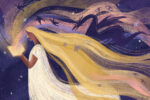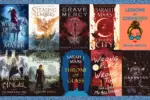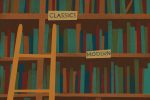Once upon a time, there was a person who traveled their way through stories that bridged one month into the next. As 12 months came to a close, all they could do was sit and reflect on the wonderful stories that encompassed their time over the year. Does this sound familiar? Every person crafts an incredible number of new stories each month, all of which end up defining their entire year. With the ending of each year, there’s a recurring need to reflect on the moments that made the year the brightest one to date — even if that’s not entirely true all the time.
When those memories are made, it’s difficult to recognize how those stories comprise the highs and lows of a year fully lived, because they bend and shape to a given moment. In retrospect, stories have the power to carry a person through each day in their own ways. Whether it’s an event that a person creates themselves, or something they read about, stories become a major part of a year in review.
On the subject of stories, public libraries help unlock the key to exploring new tales each day. Coupled with a winding-down year, libraries have much to show for what the population reads day after day, and even the way everyone likes to read. A recent article published by Quartz recounted “The Most Popular U.S. Library Books of 2021,” which brought a new light to how each city and state may share the same reading habits — or not.
As a whole, fiction took the top spot as the most popular genre to borrow from libraries in 2021. The escapism of this genre is telling of the benefits reaped from reading fiction, but these stories are joined by an array of nonfiction tales as well. Titles range widely on this list, from the fictitious wonder “Where the Crawdads Sing” by Delia Owens to “A Promised Land” by former President Barack Obama. The diversity of library books read by the general public is definitely something to smile about. Whether a person leans more towards fiction or nonfiction, Quartz revealed that all of these readers overlap in their love for frequenting the local library.
The report also dives into the ways library books have evolved over time. “Not surprisingly,” one hit feature of libraries this year is a growing love for eBooks. The many advantages of eBooks let the format prevail over its paperback counterparts, especially in terms of its portability for someone who’s constantly on the go. These eBook preferences came together with the temporary nature of library books to create the easiest and most attainable way for avid readers to devour new texts. In short, eBooks provided a way to frequent one’s public library without ever stepping foot in the building.
When libraries had to temporarily shut down or readjust to new protocols, eBooks made for a better borrower experience at such an unsure time. The thrill of a new selection — sans the commitment that comes with purchasing something new — was made more appealing by the fact that library books could now go straight to one’s personal device. Because the format helps propel, as the American Library Association calls it, “a trend of library activities beyond physical walls,” the rise in eBook love should not come as a shock on this Quartz list. The ability to borrow books from the comfort of your own device, while also frequenting the public haven, has made these digital transactions a favorite.
For what it’s worth, the ability of libraries to adapt to present needs without immense compromises has made them more relevant than ever. If you walk into the library looking for one book and come out with 10 entirely different genres, it’s that essence of trying something new that sustains the library. With so many people inside with “nothing to do,” the library offered that saving grace — its variety of materials — but without the commitment.
Library books became the reason that Quartz’s list is overflowing with different genres and writing styles, since people now had the ability to try these new texts for themselves. Going outside of your comfort zone, or exploring new authors within it, provides avenues for you to fill with the diversity of library books. And if something doesn’t work out — because everyone has different tastes — it just takes a simple return to leave the book for someone else to discover.
Though the joys of library books and their popularity shine through Quartz’s report, it’s far from a complete and perfect analysis. For example, the site provides a map of the cities that are covered in their report on popular library books: From San Francisco to New York, to Salt Lake City and Omaha, it still seems like there are a few omissions.
However, if you’re disappointed that your city’s not represented on this map, do not fret. There’s a high chance that many opinions were left out of this particular list since only a handful of data was acquired out of all the stats Quartz hoped to gain.
Even at the beginning of their 2021 roundup, the site explicitly outlined the following disclaimer: “The data are a result of a Quartz survey of 36 public libraries in the largest cities across the U.S. Of those, 14 provided us data on their most popular books.” Despite being an accurate analysis, the final generalizations are severely limited to what the publication itself could access. It’s then up to the reader to decide if the small pool of results is enough to make a decent judgment on this year’s best reads. There’s nothing insignificant about the data set; yet at the same time, the lack of coverage for public libraries nationwide does cut out many voices that might sway the bigger picture.
However popular Quartz’s list gets — in terms of how far and wide it spreads on social media, etc. — it’s not the only site that generated a report of the “best” library books of the year: Take Book Riot’s “New York Public Library’s Top Checkouts of 2021” for example. While some titles may look familiar to the Quartz list, both the presence of young adult fiction and the diversity of authors is greater.
Oftentimes, the reported checkout habits diverge from Quartz’s more general list; not only do the NYPL’s top library books look different, but even places like D.C.’s Public Library have their own set of fiction and nonfiction favorites. Though these major cities share their checkout lists with the world via the web, this leaves much to say about the texts popular in your own town.
As silly as these lists of library books may be to some, their significance speaks more to the ways that libraries are supportive hubs for all. According to the American Library Association, there are over 116,000 kinds of libraries across the nation today. These libraries range from public, university and even government-specific buildings, all with the sole intention of helping people find all kinds of information. The same desires lie within the various exteriors of libraries: Wherever you are in the world, a variety of books are there to help you move closer to your goals, or just provide you with some relief from your day-to-day activities.
Lists like Quartz’s year-end roundup mainly serve as a reminder that these resources are there for full community support. Regardless of how high or low one’s favorite books rank on this list, it’s the fact that people are continuing to frequent the public library system that makes it worthwhile. While books can physically change and genre tastes can vary, the public library remains steadfast. No matter who you are or what you’re looking for, the humble library encases volumes of knowledge for anything you could imagine. After all, you never know if the next story will reveal your happily ever after.

















